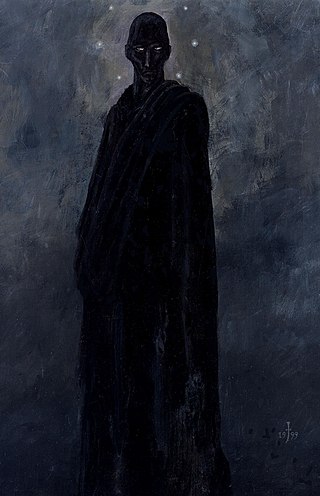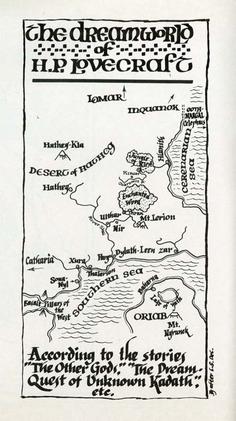
The Cthulhu Mythos is a mythopoeia and a shared fictional universe, originating in the works of American horror writer H. P. Lovecraft. The term was coined by August Derleth, a contemporary correspondent and protégé of Lovecraft, to identify the settings, tropes, and lore that were employed by Lovecraft and his literary successors. The name "Cthulhu" derives from the central creature in Lovecraft's seminal short story "The Call of Cthulhu", first published in the pulp magazine Weird Tales in 1928.

Nyarlathotep is a fictional character created by H. P. Lovecraft. The character is a malign deity in the Cthulhu Mythos, a shared universe. First appearing in Lovecraft's 1920 prose poem "Nyarlathotep", he was later mentioned in other works by Lovecraft and by other writers. Later writers describe him as one of the Outer Gods, an alien pantheon.

Mi-Go are a fictional race of extraterrestrials created by H. P. Lovecraft and used by others in the Cthulhu Mythos setting. The word Mi-Go comes from "Migou", a Tibetan word for yeti. The aliens are fungus-based lifeforms which are extremely varied due to their prodigious surgical, biological, chemical, and mechanical skill. The variants witnessed by the protagonist of "The Whisperer in Darkness" resemble winged human-sized crabs.

"The Call of Cthulhu" is a short story by American writer H. P. Lovecraft. Written in the summer of 1926, it was first published in the pulp magazine Weird Tales in February 1928.

Azathoth is a deity in the Cthulhu Mythos and Dream Cycle stories of writer H. P. Lovecraft and other authors. He is the ruler of the Outer Gods, and may be seen as a symbol for primordial chaos.

Fungi from Yuggoth is a sequence of 36 sonnets by cosmic horror writer H. P. Lovecraft. Most of the sonnets were written between 27 December 1929 – 4 January 1930; thereafter individual sonnets appeared in Weird Tales and other genre magazines. The sequence was published complete in Beyond the Wall of Sleep and The Ancient Track: The Complete Poetical Works of H. P. Lovecraft. Ballantine Books’ mass paperback edition, Fungi From Yuggoth & Other Poems included other poetic works.

The Elder Things are fictional extraterrestrials in the Cthulhu Mythos. The beings first appeared in H. P. Lovecraft's novella, At the Mountains of Madness, and later appeared, although not named, in the short story "The Dreams in the Witch-House" (1933). Additional references to the Elder Things appear in Lovecraft's short story "The Shadow Out of Time" (1936).

At the Mountains of Madness is a science fiction-horror novella by American author H. P. Lovecraft, written in February/March 1931 and rejected that year by Weird Tales editor Farnsworth Wright on the grounds of its length. It was originally serialized in the February, March, and April 1936 issues of Astounding Stories. It has been reproduced in numerous collections.

The Dream Cycle is a series of short stories and novellas by author H. P. Lovecraft (1890–1937). Written between 1918 and 1932, they are about the "Dreamlands", a vast alternate dimension that can only be entered via dreams.

The Dream-Quest of Unknown Kadath is a novella by American writer H. P. Lovecraft. Begun probably in the autumn of 1926, the draft was completed on January 22, 1927 and it remained unrevised and unpublished in his lifetime. It is both the longest of the stories that make up his Dream Cycle and the longest Lovecraft work to feature protagonist Randolph Carter. Along with his 1927 novel The Case of Charles Dexter Ward, it can be considered one of the significant achievements of that period of Lovecraft's writing. The Dream-Quest combines elements of horror and fantasy into an epic tale that illustrates the scope and wonder of humankind's ability to dream.

The Deep Ones are creatures in the Cthulhu Mythos of H. P. Lovecraft. The beings first appeared in Lovecraft's novella The Shadow over Innsmouth (1931), but were already hinted at in the early short story "Dagon". The Deep Ones are a race of intelligent ocean-dwelling creatures, approximately human-shaped but with a fishy appearance. The males would regularly mate with involuntary human females along the coast, creating societies of hybrids.

The Whisperer in Darkness is a 26,000-word novella by American writer H. P. Lovecraft. Written February–September 1930, it was first published in Weird Tales, August 1931. Similar to The Colour Out of Space (1927), it is a blend of horror and science fiction. Although it makes numerous references to the Cthulhu Mythos, the story is not a central part of the mythos, but reflects a shift in Lovecraft's writing at this time towards science fiction. The story also introduces the Mi-Go, an extraterrestrial race of fungoid creatures.

The Martians, also known as the Invaders, are the race of extraterrestrials and the main antagonists from the H.G. Wells 1898 novel The War of the Worlds. They are the main antagonists of the novel, and their efforts to exterminate the populace of the Earth and claim the planet for themselves drive the plot and present challenges for the novel's human characters. They are notable for their use of extraterrestrial weaponry far in advance of that of mankind at the time of the invasion.
"Allan and the Sundered Veil" is a six-part horror comic story written in the style of a boy's periodical by Alan Moore and illustrated by Kevin O'Neill, included at the back of each issue of The League of Extraordinary Gentlemen, Volume I and collected at the back of that volume. It serves as a prequel to the comic.
American author H. P. Lovecraft (1890–1937) created a number of fictional deities throughout the course of his literary career. These entities are usually depicted as immensely powerful and utterly indifferent to humans, who can barely begin to comprehend them; however, some entities are worshipped by humans. These deities include the "Great Old Ones" and extraterrestrials, such as the "Elder Things", with sporadic references to other miscellaneous deities. The "Elder Gods" are a later creation of other prolific writers who expanded on Lovecraft's concepts, such as August Derleth, who was credited with formalizing the Cthulhu Mythos. Most of these deities were Lovecraft's original creations, but he also adapted words or concepts from earlier writers such as Ambrose Bierce, and later writers in turn used Lovecraft's concepts and expanded his fictional universe.

Providence is a twelve-issue comic book limited series written by Alan Moore and illustrated by Jacen Burrows, published by American company Avatar Press from 2015 to 2017. The story is both a prequel and sequel to Moore's previous stories Neonomicon and The Courtyard, and continues exploring H. P. Lovecraft's Cthulhu Mythos.
This is a list of fictional creatures from the Cthulhu mythos of American writer H. P. Lovecraft and his collaborators.













